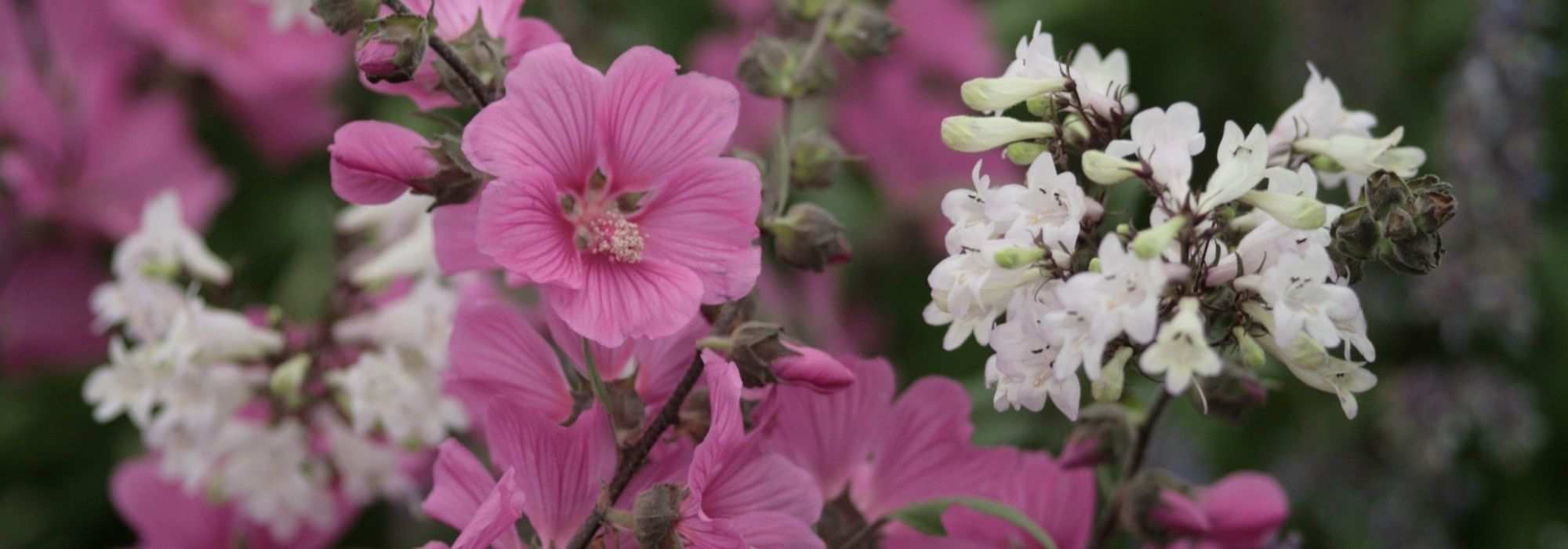
Pairing Lavateras
Discover our 6 combinations with the lovely lavateras
Contents
Lavateras are native to coastal and Mediterranean areas. They form large bushes that can be as wide as they are tall, exceeding two metres. Their grey-green foliage is fuzzy or crinkled. They flower abundantly in a range from pale pink to fuchsia. Their long flowering period lasts from early spring to late autumn in coastal regions. Similar to other mallows like hollyhocks, with which they can be confused, their rapid growth and natural habit adapt to all types of gardens in mild winters, but always in well-draining soil. Newer compact varieties perform very well in pots. They are suited to full sun or light shade and should be watered regularly during the summer.
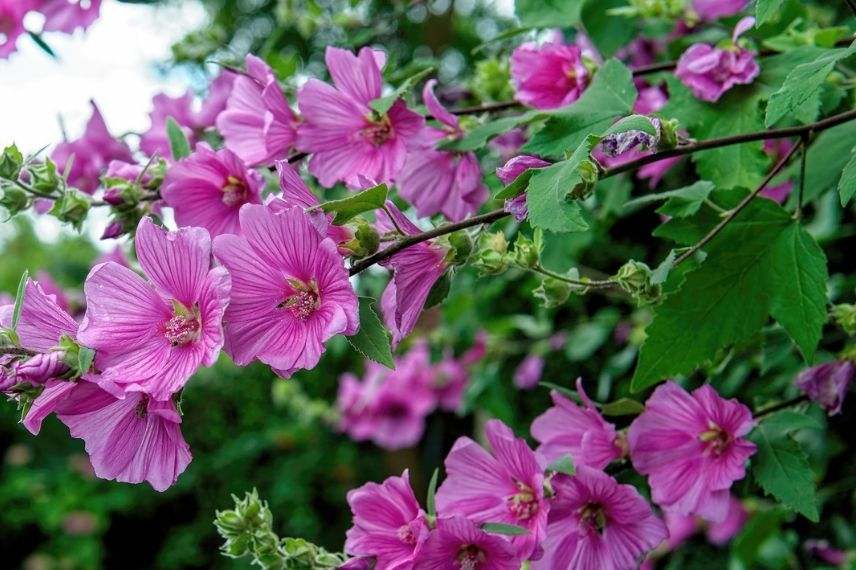 Lavateras are plants to rediscover for their elegant and romantic appearance. They will add volume to your borders without weighing them down.
Lavateras are plants to rediscover for their elegant and romantic appearance. They will add volume to your borders without weighing them down.
Discover our 6 favourite combinations with lavateras: elegant and natural in a seaside garden, romantic and generous in a very “British” vintage garden, or even surprising in a dry garden or in pots on a terrace. They will also add a touch of indulgence to the vegetable garden!
To avoid any failures, we recommend planting appropriately, using our web application Plantfit.
In a seaside garden
Lavatera, native to the Mediterranean basin, also thrives on the Atlantic coast, sheltered from strong winds, but always in well-drained soil. The Lavatera ‘Blue Bird’ forms a remarkable bush with deciduous green-grey foliage. This hardy variety can withstand temperatures down to -10°/ -12 °C and performs very well in winter, provided the soil is well-drained. Charming and bright even in partial shade, it elegantly adorns with its light blue-mauve flowering, finely veined with violet. The flower spikes of Mexican sage Salvia leucantha bear countless small white flowers in velvety purple-violet calyces. This sage, which flowers in winter, captivates with its simplicity and floribundity. Its grey-green foliage remains beautiful all year round but can be somewhat tender in humid and cold climates; however, it proves robust and resilient in sheltered situations with well-drained soil. Present this lovely bouquet in a majestic setting composed of fluffy pink spikes from Filipendula rubra ‘Venusta’‘ and the velvety dark green foliage of Hydrangea aspera‘Villosa’, whose mauve flowers, present in hundreds, will astonish your friends.
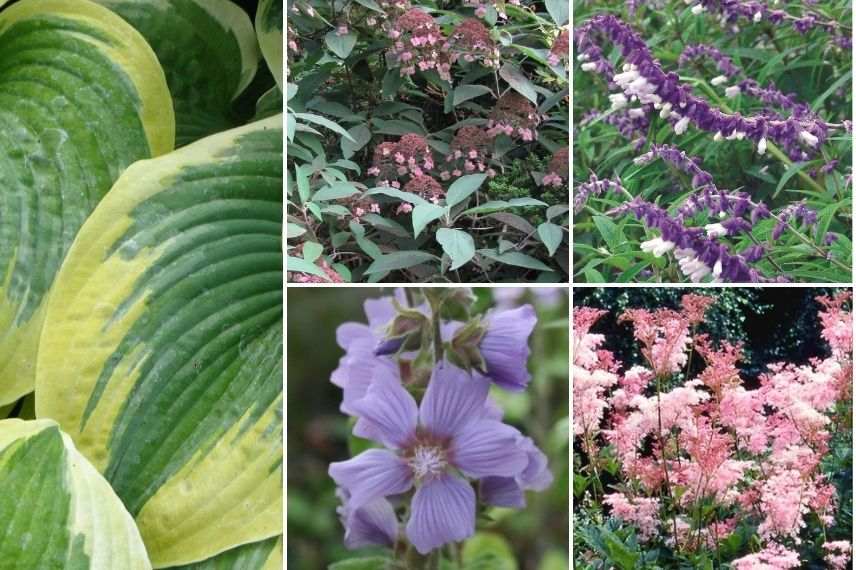
The large foliage of Hosta ‘Robert Frost’, marginate with cream-white, accompanies the blue-flowered lavatera under the dome of Hydrangea ‘Villosa’ and the blue spikes of leucantha, crowned with the pink plumes of filipendula
In a "Cottage garden" spirit
Lavatera ‘Barnsley Baby’ showcases the “cottage garden” spirit of a small space by quickly creating a lovely jumble. Its abundant flowering with large soft pink corollas complements the tall bushes of Fuchsia magellanica ‘Versicolor’. It blooms until the frosts with bicoloured fuchsia red bell-shaped flowers. Its soft green foliage, veined with red, is marginate with white. The variegated bugle, Ajuga reptans ‘Golden Glow’‘ with its discreet blue flowers brings light in winter with its variegated foliage of cream, pink, and soft yellow. The columbines Aquilegia flabellata ‘Mini star’ are simple and delicate flowers in bright lavender blue with a cream calyx. The fluffy pink spikes of the Kansas Plume Liatris spicata adorn the mist of the bronze fennel Foeniculum vulgare purpureum ‘Giant bronze’ from which you can create beautiful bouquets that last a long time.
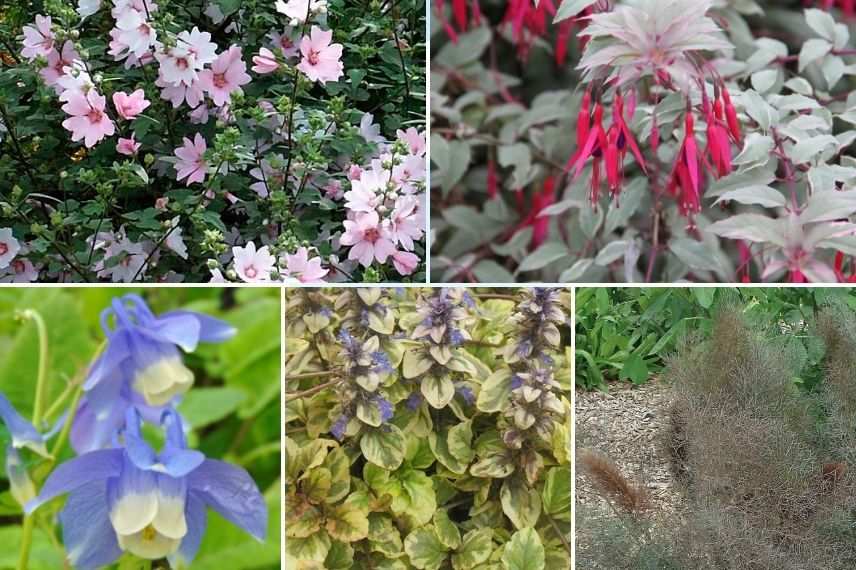
The lavatera ‘Barnsley Baby’ mingles with the soft blue columbines. The bells of the Fuchsia emerge from the bronze fennel on a carpet of variegated bugle.
Discover other Lavatera - Tree Mallow
View all →Available in 2 sizes
Available in 0 sizes
Available in 2 sizes
Available in 1 sizes
Available in 1 sizes
Available in 1 sizes
Available in 1 sizes
Available in 1 sizes
Available in 1 sizes
Available in 1 sizes
In a very British border garden
The flowering of Lavatera thuringiaca ‘Bredon Springs’ will thrive in this majestic setting formed by the large panicles of the beautiful Phlox paniculata ‘Jeana’ with its soft lavender hues. Its grey-green, slightly fuzzy foliage will be complemented by the large thistles. The giant sea holly Eryngium giganteum creates a very graphic design with its silvery, finely cut foliage. You might prefer the star-shaped, lapis lazuli blue heads of Eryngium zabelii ‘Big Blue’. The unusual, mossy coloured spheres of Allium amethystinum ‘Red Mohican’ will punctuate the view as it wanders among the flowers of the lavatera.
At the back of the border, install the tall spires of Macleya cordata. They offer magnificent bluish-green foliage and an abundant summer flowering with spikes of small cream flowers that turn pink and then russet in autumn. This is a lovely, lush plant that thrives in full sun, whether planted alone or at the back of a border.
The lightness of Melica altissima ‘Atropurpurea’, with its slightly wild appearance, adds a touch of sophistication to the composition of this border. The space left in this pretty “so British” jumble will welcome the airy flowers of Cleome senorita ‘Blanca’, which will bloom white until autumn.
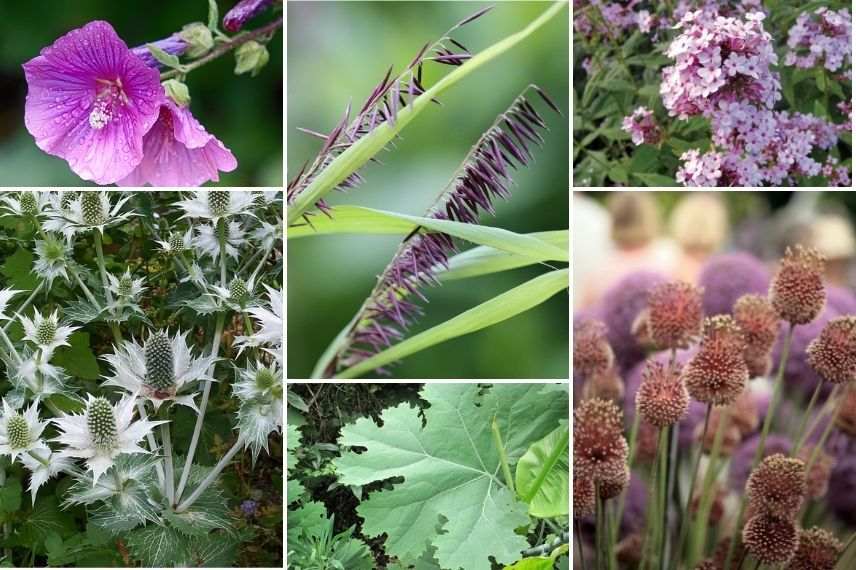
On the left, the lavatera ‘Bredon Springs’ and the Eryngium zabelii, in the centre the spikes of Melica altissima atropurpurea and the finely cut foliage of Macleya cordata, on the right the Phlox ‘Jeana’ and the Allium ‘Red Mohican’
Read also
Choosing a lavateraTo soften a silver garden
The upright, downy grey-green stems and heavily flowered of the tree mallow Lavatera maritima will add a touch of softness to your dry garden. To its corollas of washed white with lilac pink and a striking deep red heart, add the lightness and elegance of the flowering of the Buenos Aires verbena Verbena bonariensis in the same colour palette. The purple and grey as a background note will be complemented by the scarlet blooms of the campion Lychnis coronaria and the stunning Lysimachia atropurpurea ‘Beaujolais’. No grey garden is complete without a carpet of grey-blue velvet from the bear’s ear betony Stachys byzantina, which you will embellish with deep dark spots from the elegant foliage of the Ophiopogon planiscapus ‘Nigrescens’. You can easily recreate this atmosphere by placing them in pots on your terrace or balcony, as most of these beautiful silver plants enjoy sunny, slightly shaded, and sheltered spots on a terrace.

Softness and generosity where the large corollas of Lavatera maritima intertwine with Verbena bonariensis and the campion on a rich black and white carpet between the ophiopogon and stachys
In a pot on a terrace
Lavatera adapts perfectly to pot, container, or window box cultivation. However, it requires winter protection for evergreen foliage. Choose Lavatera ‘Candy Floss’ and Lavatera ‘Blushing Bride’, which are quite hardy. They withstand sea spray well and can therefore enhance your seaside terraces. The ‘Candy Floss’ variety produces soft lavender flowers, while ‘Blushing Bride’ boasts pure white flowers with a hint of pink. Its flowers are ephemeral but continuously renew from June to October. Ensure a sufficiently wide pot for its spreading habit, which quickly reaches 1m to 1.5m in height and 1m to 1.2m in width. They find their place among pots of Hosta, Eucomis or Trillium recurvatum. The unusual flower of Trillium is upright, narrow, and tall. It consists of three arching reddish-brown petals above six black stamens that curve over the pistil. Similarly, you will be amazed by the spectacular flowers of the variegated pineapple plant Eucomis vandermerwei. This enigmatic and very original small bulbous plant displays a rosette of green foliage, speckled with maculate and brown spots. It produces amusing pineapple-shaped flowers, tinged with chocolate purple, topped with a tuft of dark leaves in early summer. This small plant reliably re-blooms, making it ideal for pot cultivation. It requires perfectly drained soil, morning sun, and afternoon shade.
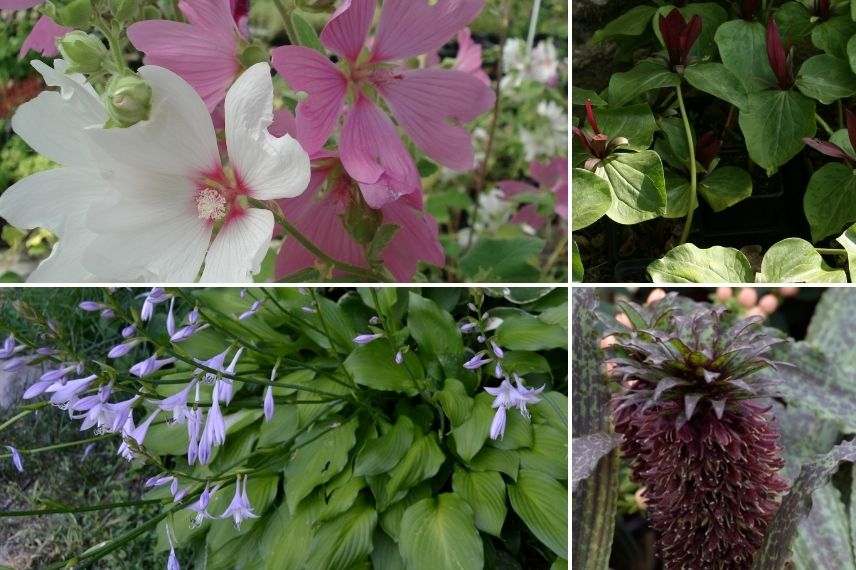 Lavateras ‘Candy Floss’ and ‘Blushing Bride’ contrasting with Trillium and Eucomis, extraordinary plants amidst the broad leaves of Hosta.
Lavateras ‘Candy Floss’ and ‘Blushing Bride’ contrasting with Trillium and Eucomis, extraordinary plants amidst the broad leaves of Hosta.
In the flowering vegetable garden
The principle of a flowering vegetable garden, besides mixing flowers and vegetables, is to combine shapes and colours between vibrant flowerings and contrasting foliage for visual delight. Pair the deep pink flowering Lavatera ‘Burgundy Wine’ with the generous Lysimachia ciliata ‘Fire Cracker’ featuring chocolate tones sprinkled with star-like yellow sunflowers at the end of summer. They will delightfully nestle amidst the graceful spikes of Pennisetum setaceum rubrum and the airy flowering of Anethum graveolens until autumn. Your garden will be infused with the scent of chocolate from the Cosmos atrosanguineus ‘Black Magic’ for a delicious and unusual touch. Its deep purple colour will be accentuated by the abundant orange flowering of Tropaeolum tuberosum with the red calyx of the charming tuberous nasturtium. You can then create checkerboards by sowing amaranths between cabbages or salads and highlight everything with marigolds.
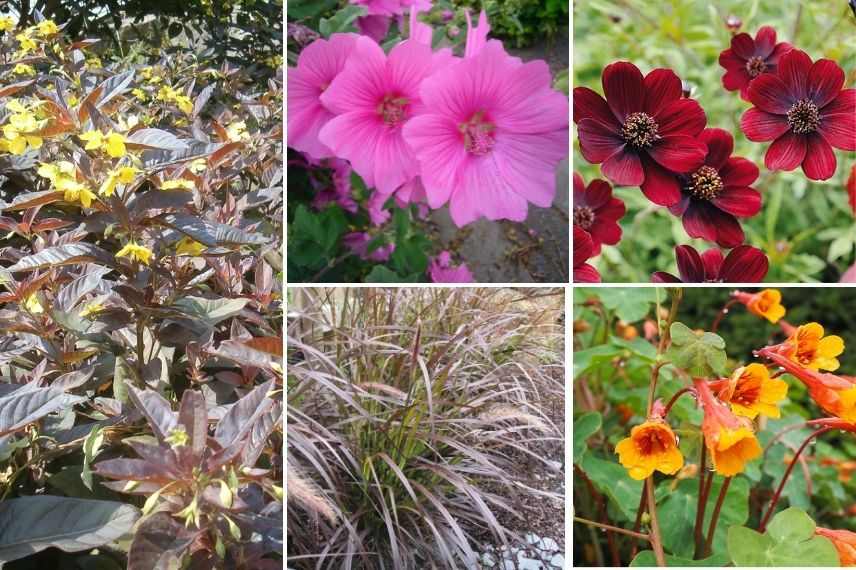
Vibrant flowering of the deep pink Lavatera ‘Burgundy Wine’, softened by Pennisetum rubrum. The sensual Cosmos ‘Chocolate’ and the large liana of the tuberous nasturtium overshadow the childlike touch of the strange sunflowers of Lysimachia ciliata ‘Fire Cracker’
- Subscribe!
- Contents
































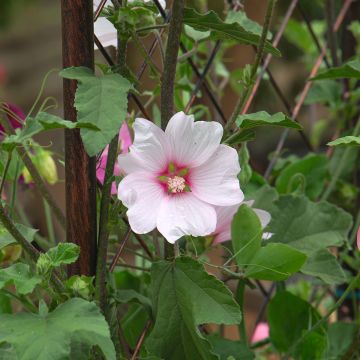
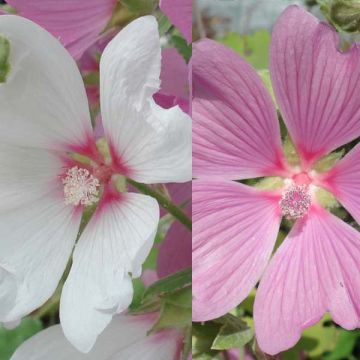

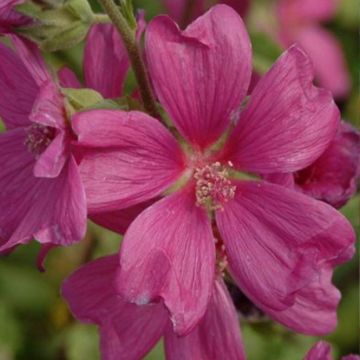

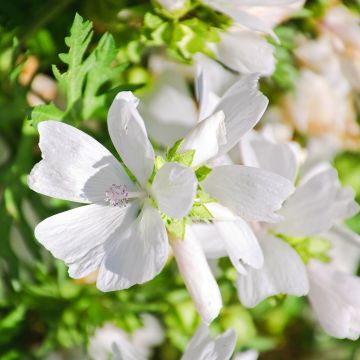
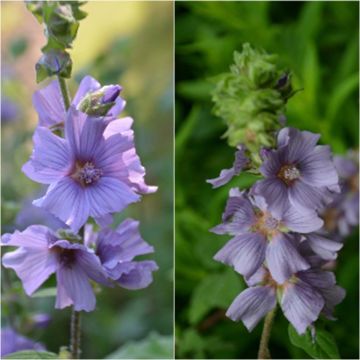
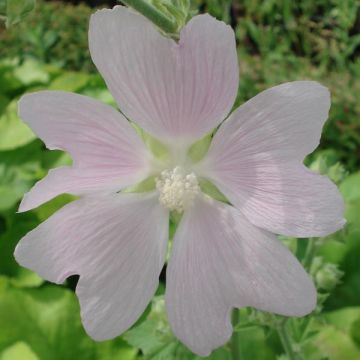
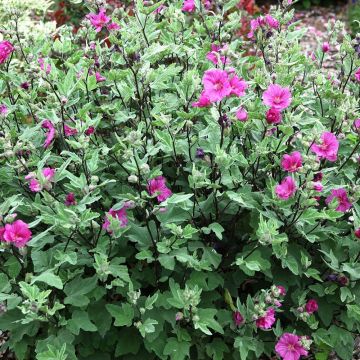

Comments